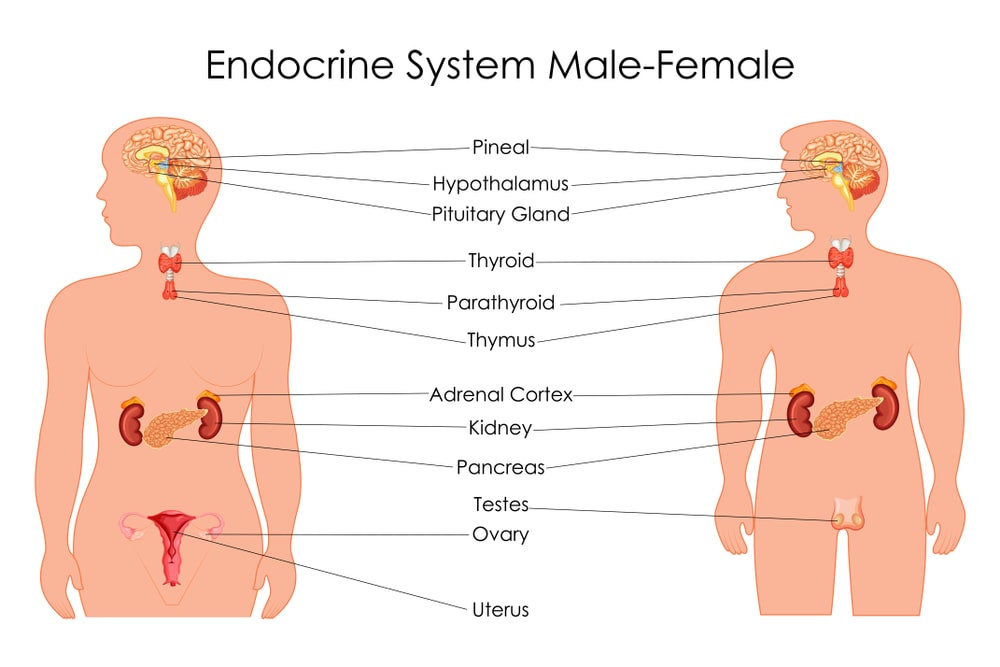Endocrine System
The Endocrine system is one of the important systems of the human body. The Endocrine system and the nervous work together to coordinate functions of all body systems.
- The endocrine system is composed of endocrine glands and hormones.
- Hormones are the main part of the endocrine system. A hormone is a chemical that is secreted by different glands in the body.
- Hormones secreted by the gland enter interstitial fluid and then the bloodstream reaches a specific cell (called the target cell) and shows action by binding to specific receptors on the cell.
- The human body contains two types of glands- endocrine glands and exocrine glands.
- Endocrine glands (endo- within) secrete hormones into the interstitial fluid surrounding the secretory cells rather than into ducts. From the interstitial fluid, hormones diffuse into blood capillaries and blood carries them to target cells throughout the body.
Examples of endocrine glands:
- Adrenal gland
- Parathyroid gland
- Pineal gland
- Pituitary gland
- Thyroid gland
In addition to endocrine glands, some organs and tissues contain cells that secrete hormones. But they are not called endocrine glands. Examples: the hypothalamus, thymus, pancreas, ovaries, testes, kidneys, stomach, liver, small intestine, skin, heart, adipose tissue, and placenta.
- Exocrine glands (exo- outside) secrete their products into ducts that carry the secretions into body cavities, into the lumen of an organ, or to the outer surface of the body.
Examples of exocrine glands:
- Sudoriferous (sweat) gland
- Sebaceous (oil) gland
- Mucous gland
- Digestive gland
Endocrine Glands and Their Secretions
Pituitary Gland
The pituitary gland is a pea-shaped structure that measures 1-1.5 cm (0.5 in) in diameter and lies in the hypophyseal fossa of the sphenoid bone.
It attaches to the hypothalamus by a stalk, the infundibulum (a funnel), and has two anatomically and functionally separate portions:
- Anterior pituitary
- Posterior pituitary
Hormones Secreted by Anterior Pituitary:
- The anterior pituitary or adenohypophysis secretes hormones that regulate a wide range of bodily activities, from growth to reproduction.
- The release of anterior pituitary hormones is stimulated by releasing hormones and suppressed by inhibiting hormones from the hypothalamus.
Following hormones are secreted by the anterior pituitary:
- Human Growth Hormone and Insulin-like Growth Factors (IGFs): Human growth hormone increases the synthesis of IGFs. IGFs are responsible for the growth of the body.
- Thyroid Stimulating Hormone (TSH): It stimulates the synthesis and secretion of the two thyroid hormones, triiodothyronine, and thyroxine, produced by the thyroid gland.
- Follicle Stimulating Hormone (FSH): It initiates the development of several ovarian follicles. FSH also stimulates follicular cells to secrete estrogens (female sex hormones). In males, FSH stimulates sperm production in the testes.
- Luteinizing Hormone (LH): In females, luteinizing hormone (LH) triggers ovulation, the release of a secondary oocyte (future ovum) by an ovary.
- Prolactin (PRL): It initiates and maintains milk secretion by the mammary glands.
- Adrenocorticotropic Hormone (ACTH): ACTH controls the production and secretion of cortisol and other glucocorticoids by the cortex (outer portion) of the adrenal glands.
- Melanocyte Stimulating Hormone (MSH): Exact role of MSH in humans is unknown.
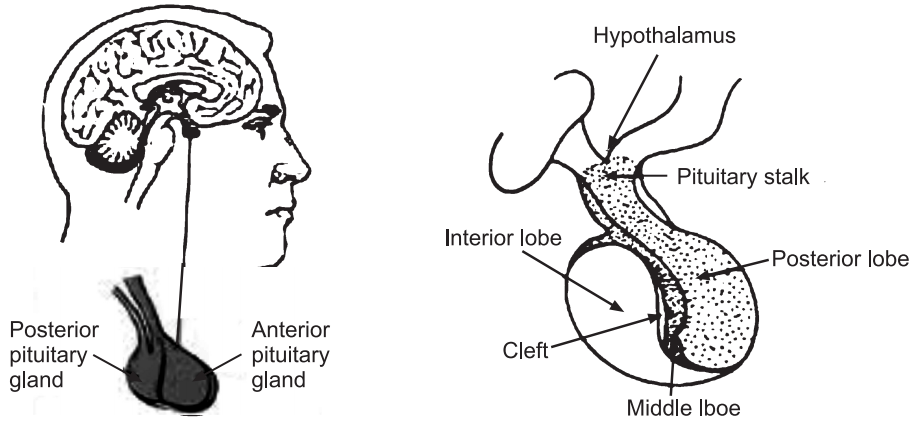
Posterior Pituitary:
Although the posterior pituitary or neurohypophysis does not synthesize hormones, it does store and releases two hormones.
- Oxytocin: During childbirth, oxytocin enhances the contraction of the uterus. After childbirth, oxytocin stimulates milk ejection from the mammary glands in response to the mechanical stimulus provided by a suckling baby.
- Antidiuretic Hormone (ADH): It decreases urine production. It acts on the kidneys.
Thyroid Gland
- The butterfly-shaped thyroid gland is located just inferior to the larynx (voice box).
- It is composed of the right and left lateral lobes, one on either side of the trachea, that are connected by an isthmus anterior to the trachea.
The thyroid gland secretes two hormones:
- Thyroxine, (also called tetraiodothyronine or T4 because it contains four atoms of iodine).
- Triiodothyronine (also called T3, because it contains three atoms of iodine).
Functions:
Thyroid hormones increase basal metabolic rate (BMR), the rate of oxygen consumption under standard or basal conditions (awake, at rest, and fasting).
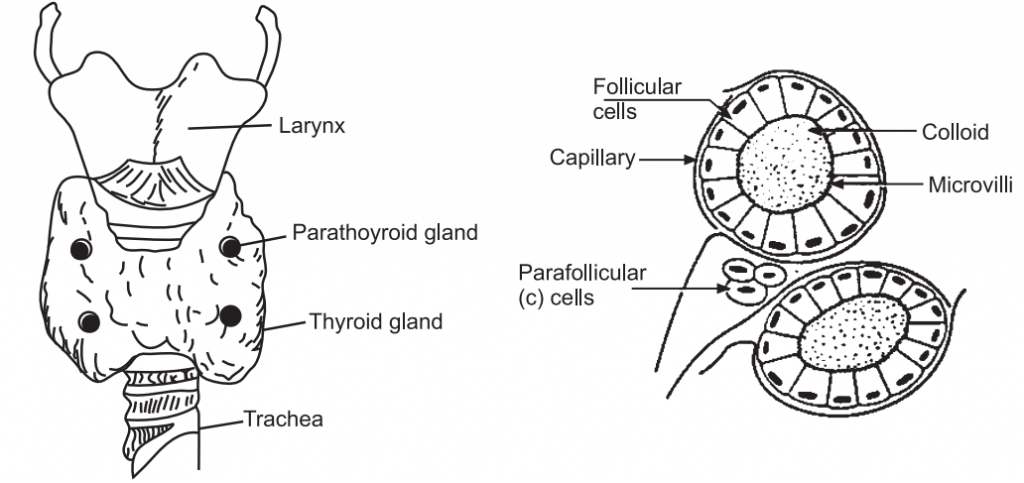
Parathyroid Glands
- Parathyroid glands are several small, round masses of tissue that are partially embedded in the posterior surface of the lateral lobes of the thyroid gland.
- These glands secret parathyroid hormone also called parathormone. Parathyroid hormone is the major regulator of the levels of calcium (Ca2+), magnesium (Mg2+), and phosphate (HPO4 2–) ions in the blood.
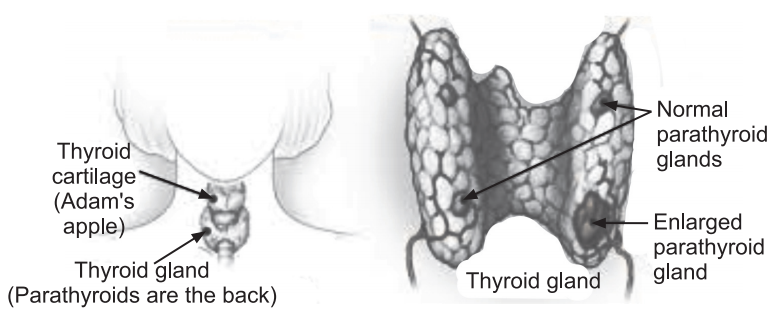
Adrenal Glands
- Adrenal glands also called suprarenal glands, are located superior to each kidney.
- These glands have a flattened pyramidal shape.
- The adrenal glands are made up of two distinct regions:
Adrenal cortex: It is a large, peripherally located region of the gland.
The hormones secreted by the adrenal cortex are:
1. Mineralocorticoids: Aldosterone is the major mineralocorticoid secreted by adrenal gland. It regulates the homeostasis of two mineral ions, namely sodium ions (Na+) and potassium ions (K+), and thus helps to adjust blood pressure and blood volume.
2. Glucocorticoids: Glucocorticoids are responsible for the breakdown of proteins and lipids.
- Glucocorticoids provide resistance to stress.
- Glucocorticoids have anti-inflammatory effects.
- Glucocorticoids decrease immune responses.
3. Androgens, steroid hormones: In females, adrenal androgens are responsible for promoting libido (sex drive). In males, adrenal androgens don’t have significant effects.
Adrenal medulla: It is a small, centrally located region of the gland. The two major hormones synthesized by the adrenal medulla are:
- Epinephrine or adrenaline
- Norepinephrine or noradrenaline
These two hormones only intensify sympathetic responses in other parts of the body. An important effect is on the cardiovascular system, they increase blood pressure.
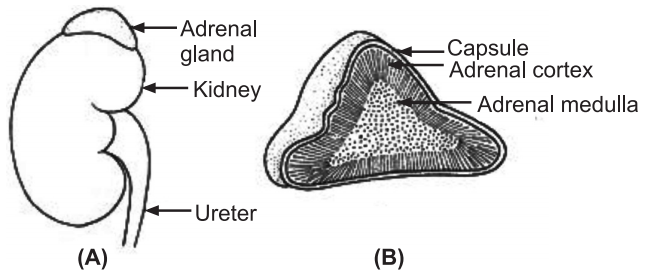
Pancreas
- The pancreas is both an endocrine gland and an exocrine gland.
- It is a flattened organ that measures about 12.5–15 cm in length.
- It is located in the curve of the duodenum which is the first part of the small intestine.
- The endocrine tissue of the pancreas is called pancreatic islets or islets of Langerhans.
- Each pancreatic islet includes four types of hormone-secreting cells: A, B, D, and F cells.
- Alpha or A cells secrete glucagon. When blood glucose level decreases, glucagon is responsible for increasing blood glucose.
- Beta or B cells secrete insulin. When blood glucose level increases, insulin is responsible for decreasing blood glucose level to normal.
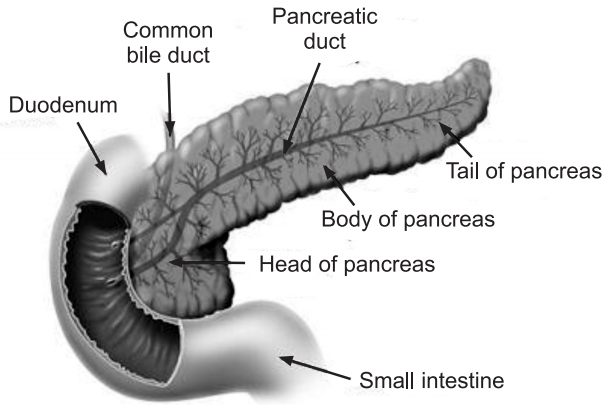
- Delta or D cells secrete somatostatin.
- F cells secrete pancreatic polypeptide.
Make sure you also check our other amazing article on : Excretory Products and Their Elimination
